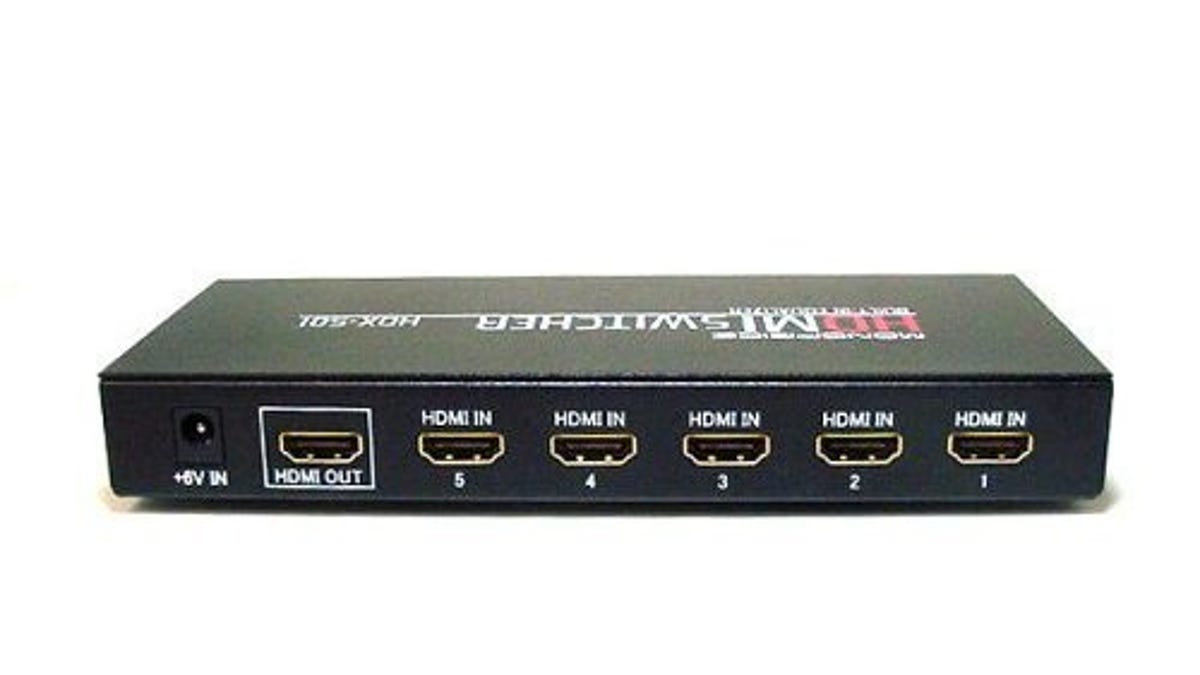Expand your HDMI options on the cheap
Just as HDMI capacity is becoming more important than ever to the average home theater setup, HDMI switchers are dropping in price.

HDMI isn't just for HDTVs any more. As the high-def movement continues to march forward, HDMI connections are becoming standard equipment on everything from cable and satellite boxes, DVRs, game consoles, AV receivers, and DVD players to network media devices, PC video cards, and even camcorders. That means even a fairly modest home theater setup--say, an HD DVR, PlayStation 3, Apple TV, and a DVD recorder--could have three or more HDMI-equipped AV sources. While many higher-end TVs and AV receivers are beginning to sport three or even four HDMI inputs, the industry standard is still stuck at around two.
Traditionally, HD aficionados suffering from an HDMI deficit would bite the bullet and run their sources via component once they ran out of HDMI inputs. But doing so obviates the whole advantage of HDMI to begin with; in addition to losing any fidelity advantage offered by HDMI, you quadruple or quintuple the cable needs (three separate component cables, plus one or two for audio) per source. But there's an easy and straightforward solution: an HDMI switcher. Switchers have one simple task--toggling between multiple inputs--and they can expand the number of available HDMI inputs to your HDTV or AV receiver by a factor of two, three, or even four.
Professional-grade switchers have long been available, but at a premium. The Gefen 4x1 model used in the CNET Labs costs more than $300, and it's beginning to show its age. But newer consumer models are available for less than $200--or even $100--and they often work just as well as their more expensive cousins. For instance, the Belkin PureAV model listed for $200 when we reviewed it in 2006, but it's now widely available online for less than $85. About the only real problem with that model is that it only had three inputs. The forthcoming $100 XtremeMac model (designed to complement the Apple TV) has four. Meanwhile, a variety of "no-name" models available at MonoPrice include one model with five inputs for just $79.
We haven't yet reviewed those last two models, and HDMI equipment needs to be examined with a skeptical eye, thanks to the annoying preponderance of HDCP issues. (The Belkin, for instance, has never choked on any product we've connected to it, but you should always check user reviews to see how these devices--especially the bargain ones--actually perform.) But there are a couple of key buying tips I can offer for anybody in the market. In addition to getting a unit with as many ports as possible, make sure it's got an infrared remote, preferably with discrete inputs (i.e., access to specific inputs on command, rather than just "next input" and "previous input"). The Belkin PureAV model has that option, which allows you to program a universal remote with the requisite macros. That means the switcher can easily work in concert with your TV or AV receiver--when you hit "DVD player" on the remote, the AV receiver can be set to toggle to the HDMI input connected to the switcher, which can in turn be programmed to toggle to (for instance) "input 3," to which the DVD player is attached.
One word of warning, however: to date, none of the switchers we've spotted support HDMI 1.3. For most people, that won't be a problem in the short term; for the home theater elite, however, it could cause issues. Anyone with an HDMI 1.3-equipped source (such as a PlayStation 3 or a Toshiba HD-XA2) who's looking to access the HDMI 1.3-only features--such as Dolby True HD or DTS-HD Master Audio decoding, or xvYCC color space--will need to ensure that the components (AV receivers and TVs) have a pure HDMI 1.3 path. In other words, inserting an older switcher into the mix will throttle the extra bandwidth that HDMI 1.3 offers. If that's not an issue in the meantime, however, there's little reason not to jump on one of these increasingly affordable HDMI switchers if you need the extra ports.

